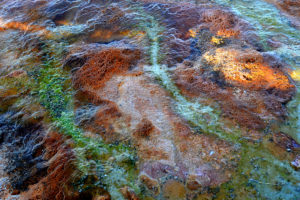
Thermophilic microbial mat in West Thumb Geyser Basin, Yellowstone National Park (Marissa Fessenden).
The Metagenome Program leverages high-throughput sequencing technologies to uncover the principles governing microbial community functions and interactions that impact ecosystem processes. Sequencing technologies have allowed us to begin decoding the information encoded in the DNA of microbes in the wild, providing a snapshot of diversity and metabolic functional potential. Knowledge of how microbes function in their environment holds tremendous potential to transform our understanding of the world and spur innovations in energy and the environment.
Among the major initiatives of the Metagenome Program are:
- Exploration of phylogenomic novelty. Advances in metagenomic sequencing, assembly, and binning have enabled reconstruction of complete or near-complete population genomes directly from the environment. These advances have led to groundbreaking discoveries in diversity and novel functions identified in unexpected microbial clades. We leverage genome-resolved metagenomics and targeted gene searches to expand representation of uncultivated microbial lineages.
- Charting viral ‘dark matter.’ Viruses are the most abundant entities in the biosphere, and impact microbial population dynamics, long-term evolution, and ecosystem functions. Sequencing technologies have massively expanded knowledge of viral diversity and have enabled exploration of distribution and ecology at a global scale. We develop computational resources to analyze viral fragments derived from metagenomic data through IMG/VR, as well as new methods to capture viral populations from the environment.
- Enabling microbiome data science. The microbiome research field is increasingly moving towards a data-driven enterprise, where we can begin to translate large-scale sequence data into biological insight. We enable analysis for community profiling using targeted amplicon sequencing (16S, 18S and ITS) through the iTagger pipeline and comparative genomics and metagenomics analysis through the IMG/M platform. The newly launched JGI-NERSC FICUS additionally supports users to perform state-of-the-art computational genomics and metagenomics research.
-
Computational systems and methods
-
More about this program